Exploring Crow Tarot: Symbolism and Application
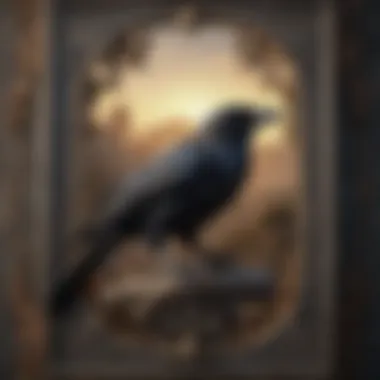
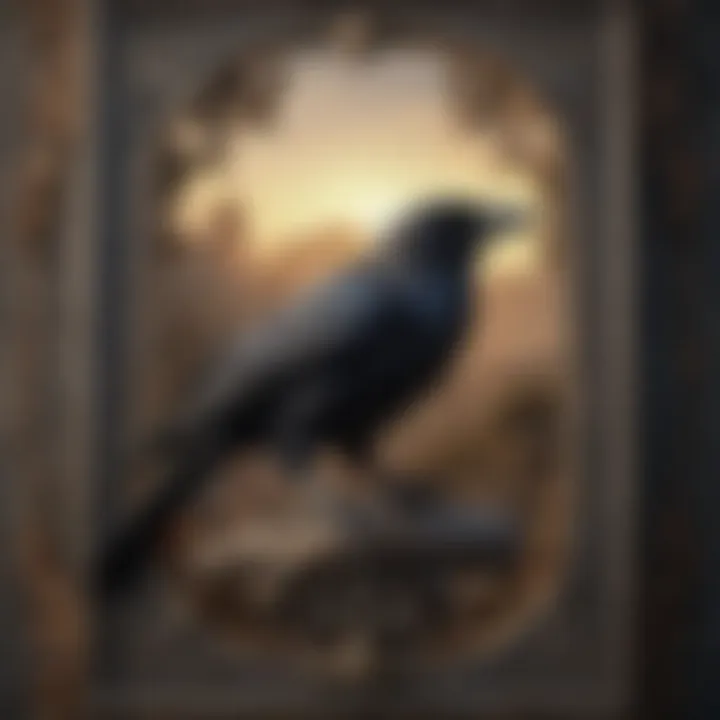
Intro
Crow Tarot, a captivating fusion of traditional Tarot with the inherent symbolism of crows, offers intriguing insights into the human experience. The deep connections between crows and various cultures enrich the narrative of this unique deck. By exploring the symbolic elements, interpretative techniques, and practical applications, both novices and seasoned practitioners can uncover the myriad layers embedded within each card. This article serves as a comprehensive guide to understanding the rich tapestry that Crow Tarot weaves and aims to enlighten readers on how to make meaningful interpretations through readings.
In the realm of Tarot, each deck presents distinct features that reflect the beliefs and characteristics of its symbolic origins. The Crow Tarot, much like its namesake, draws upon the wisdom and mystique associated with crows in folklore and mythology. Understanding these elements will allow practitioners to harness the depth of meaning these cards can provide when woven into tarot readings.
As we navigate through the intricacies of Crow Tarot, we will explore key concepts that encompass the narrative, ranging from the historical significance of crows to the detailed guidelines for conducting effective readings. In doing so, we aspire to cultivate insightful perspectives and tangible results for everyone engaged in the practice.
Preface to Crow Tarot
The introduction to Crow Tarot serves as a frame that shapes the reader's understanding of this distinct tarot form. Crow Tarot is not just a tool for fortune telling; it intertwines depths of symbolism and cultural significance. This article aims to unpack these meanings and offer readers a lens through which to interpret the deck's rich imagery and messages.
Understanding the Crow Tarot requires familiarity with its context in the larger scope of tarot practices. Readers often seek clarity, guidance, or self-exploration through tarot. Recognizing this lineage helps in appreciating how the Crow Tarot connects with these objectives. It combines traditional tarot frameworks while also introducing unique elements that resonate with the energies encapsulated by the crow.
In this section, the audience will explore the foundational concepts surrounding Crow Tarot, which includes its role as a divination tool and its recent popularity.
Understanding Tarot as a Divination Tool
Tarot, as a divination tool, offers insights into the human experience through symbolic representation. For many, it serves as a mirror reflecting inner truths or unveiling hidden aspects of their consciousness. The images on the cards can provoke thought and introspection, guiding the seeker towards new perspectives or affirming existing beliefs.
Tarot reading is not a science. It relies heavily on intuitive interpretations. Therefore, different tarot decks can elicit varied responses based on the artist’s intention, the symbolism invoked, and the readers' personal interpretations. It is essential to appreciate that tarot exists within the realm of spiritual exploration and self-discovery.
The Rise of Crow Tarot
The rise of Crow Tarot in recent years highlights a shift in how tarot practices are perceived and utilized. With its unique representations and thematic focus on the crow, it caters to an audience seeking deeper meaning in their readings. The crow’s association with transformation, mystery, and intelligence aligns with the psychological aspects of tarot readings.
Notably, Crow Tarot has gained traction among those who appreciate the blend of folklore and spirituality. Modern readers often find themselves resonating with the symbolism attached to crows across various cultures, viewing them as messengers or guides in their quests for knowledge. This popularity surge underscores a growing awareness of the crow's contributions to personal growth and decision-making, reinforcing their importance within tarot practice.
In summary, the introduction to Crow Tarot sets the foundation for exploring its value in understanding oneself and the environment. Further sections will elaborate on the cultural significance of crows, detailed breakdowns of the tarot deck, and how readers can effectively engage with the cards. By delving into both the art and the intuition involved in readings, one can truly appreciate Crow Tarot as a profound tool for navigation through life's complexities.
Cultural Significance of the Crow
The crow holds a distinctive place in cultural narratives and mythologies across the globe. This section explores the multifaceted significance attributed to crows, highlighting their impact on folklore, religious symbolism, and human psychological associations. Understanding these cultural dimensions enhances tarot readings, particularly when interpreting the Crow Tarot deck. Crows serve as potent symbols that inform both individual experiences and collective beliefs.
Crows in Folklore and Mythology
Crows are frequently featured in folklore and mythology, often embodying dual characteristics of wisdom and mischief. Various cultures revere crows as bearers of prophecy or friends of the spirit world. In many Native American traditions, for instance, the crow is viewed as a guide. It leads individuals on their spiritual journeys, providing insights into unseen realms.
In Norse mythology, crows associated with Odin are seen as symbols of knowledge and war. The two ravens, Huginn and Muninn, embody thought and memory. They highlight how these birds are often junctures of wisdom, perceptual clarity, and the late consequences of choices made.
Conversely, in some European traditions, crows are seen as omens of bad luck. Their dark plumage and scavenging behavior evoke associations with death or misfortune. Yet, this ambiguity enriches their symbolism. Some narratives allow us to delve into the complex interplay of life, death, and rebirth, echoing the cyclical nature emphasized in tarot readings.
Symbolism of Crows Across Cultures
Crows possess diverse symbolism across various cultures, deeply tied to their ecological behaviors. Their intelligence sets them apart, manifesting in behaviors indicative of problem-solving skills. In many traditions, this intelligence translates into the representation of cunningness and resourcefulness.
- In Chinese culture, crows are associated with the sun, depicted as symbols of good fortune and family unity. They are viewed as carriers of positive energy.
- In Hindu mythology, the crow carries the souls of ancestors. This enduring connection between the living and the deceased enhances the spiritual aspect of the Crow Tarot, which often reveals ancestry and past influences on current situations.
- In African traditions, the crow sometimes denotes a warning or caution, alerting people to danger. It urges consideration of one's choices, reinforcing the tarot’s moral undertones.
"Understanding the symbolism of a crow in specific cultural contexts not only enriches the tarot reading experience, it also fosters a deeper understanding of one's life's narrative."
With such rich symbolic layers, the crow invites readers into a nuanced dialogue. Appreciating its cultural significance helps refine the interpretation of Crow Tarot. The narratives and meanings behind crows pave the way for personal insights and broader worldviews, making their role in tarot significant and transformative.
The Crow Tarot Deck
The Crow Tarot Deck holds significant importance within the realm of tarot. It is not merely a set of cards but also a representation of deep symbolism and complex interpretations. This deck invites readers to engage with themes that resonate with the essence of crows as powerful symbols. The design and structure appeal to those who seek depth in their readings and personal connections to the imagery. Readers often find the Crow Tarot not just an instrument of divination but an exploration of their own psyche.
Design and Structure of the Deck
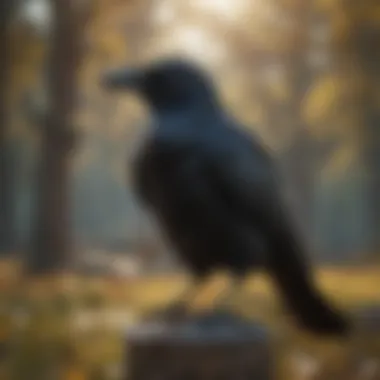
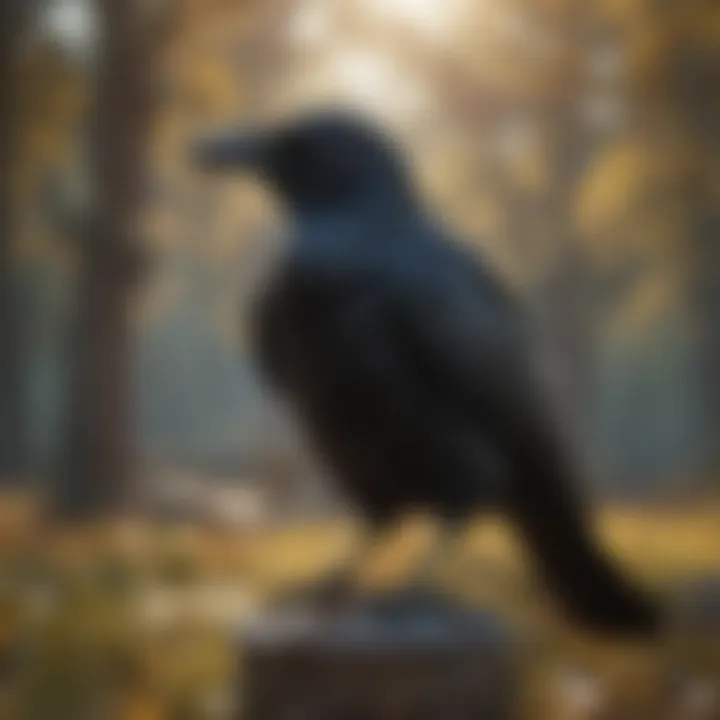
The design of the Crow Tarot Deck is unique and evocative. Each card is artfully illustrated, capturing various aspects of its symbolism. The crow itself is often depicted in different poses and contexts, symbolizing transformation, adaptability, and insight. The artwork is characterized by a monochromatic palette with splashes of color, enhancing the mystical quality of the deck. This visual language compels users to go beyond surface meanings and delve into intuitive interpretations.
The deck typically consists of 78 cards divided into two main categories: Major and Minor Arcana. The Major Arcana represents significant life lessons and spiritual growth, while the Minor Arcana addresses everyday challenges and experiences. The structure reflects a journey, akin to the cyclic nature of life and the crow's role in various motifs within human thought.
Major and Minor Arcana in Crow Tarot
The Major Arcana cards in the Crow Tarot Deck serve as guides through pivotal moments in a querent’s life. These cards convey critical life themes and existential questions. For example, The Fool might suggest new beginnings and risk-taking, while The Death card symbolizes transformation rather than a literal end. Each Major Arcana card calls for introspection, inviting the reader to consider their situation in a broader context.
In contrast, the Minor Arcana cards are divided into four suits, usually corresponding to elements like fire, water, earth, and air. Each suit focuses on specific day-to-day experiences, emotions, or actions. For instance, the suit of Cups generally aligns with emotions and relationships, often manifesting in intuitive readings. Each card in this section encourages the exploration of immediate situations, offering advice, warnings, or affirmation of one’s current path.
Integrating both Major and Minor Arcana allows for a comprehensive reading. The interplay between these cards provides layers of meaning, offering not just insight but also tactical guidance for life’s complexities. Readers can thus utilize the Crow Tarot for deep personal exploration, aiding their understanding of circumstances across various life dimensions.
Reading Crow Tarot
Reading Crow Tarot holds significant importance within the broader context of tarot practice. As practitioners engage with the Crow Tarot deck, they unlock not only the symbolic meanings behind individual cards but also their guiding principles concerning life decisions and personal growth. The unique imagery of the Crow Tarot invites introspection and a profound exploration of one’s inner world. The process fosters a relationship between the reader and the symbols, enhancing understanding through personal experience.
Preparing for a Crow Tarot Reading
To begin a Crow Tarot reading, creating a conducive environment is essential. First, find a space that is quiet and free from distractions. The atmosphere should be comforting, allowing thoughts to flow freely. Some practitioners prefer to light candles or burn incense to enhance the mood.
Preparation also involves mentally centering oneself. This can be achieved through meditation or deep breathing exercises. Approach the reading with a clear mind and an open heart. Have the Crow Tarot deck ready, and if preferred, formulate a specific question or intention for the reading.
Common Spreads Utilized in Crow Tarot
In Crow Tarot, different spreads can serve various purposes. Commonly used layouts include:
- Three-Card Spread: A simple yet effective layout for exploring past, present, and future dynamics related to the query.
- Celtic Cross Spread: This complex spread offers a more comprehensive analysis, including influences from different aspects and potential outcomes.
- Single Card Draw: For quick guidance, a single card can be drawn and interpreted based on the specific question.
Each spread allows for distinct insights and can be tailored according to the reader’s preference and the context of the inquiry.
Interpreting the Cards in Context
Interpreting the cards in context is crucial for extracting meaningful insights during a reading. This requires understanding not just the individual meanings of each card but also how they relate to one another and the overall reading.
Consider the question or situation posed during the reading; it acts as a frame through which the cards should be viewed. For instance, a card signifying conflict might take on different connotations depending on the surrounding cards.
Additionally, the intuitive understanding of the reader plays a vital role. Engaging with the imagery and energy of the Crow Tarot is paramount. Trusting one's instincts often leads to deeper, more resonant interpretations that might transcend traditional meanings.
"The art of reading tarot is not just in the cards themselves but in the connection one forms with them."
Understanding and properly utilizing these elements ensures that readings provide clarity, insight, and guidance, enhancing the overall Crow Tarot reading experience.
Interpreting Individual Cards
Understanding how to interpret individual cards is crucial in the Crow Tarot system. This knowledge not only enriches the reading experience but also enhances personal insight. Every card carries specific meanings, nuances, and symbolism that can guide the querent towards greater understanding. By studying each card's attributes, readers can uncover layers of meaning that often resonate more deeply than surface interpretations.
The process of interpreting cards allows for a dynamic exploration of personal narratives. When done well, it facilitates a dialogue between the reader, the cards, and the querent. It invites a fresh perspective on pressing issues and encourages introspection. Notably, this aspect of tarot reading is where the uniqueness of the Crow Tarot can truly shine, given its distinct imagery and symbolism.
Major Arcana Card Interpretations
Major Arcana cards in Crow Tarot serve as significant markers within a reading. They represent key life themes, major lessons, and profound transformations. Each of these cards carries rich symbols that can be pivotal in understanding a querent's journey. For instance, The Fool may imply new beginnings and adventures, reflecting a call to embrace the unknown, while Death could signify endings and rebirth, challenging individuals to confront changes with courage.
When evaluating Major Arcana cards, consider:
- The central theme it presents.
- The specific symbols and associations within the context of the reading.
- How the energy of the card correlates with the querent's experiences.
By anchoring interpretations in the collective cultural meanings as well as personal intuition, the reader can bring valuable insights to the querent's situation.
Minor Arcana Card Interpretations
Minor Arcana cards in Crow Tarot focus on day-to-day experiences. These cards reveal the dynamics of daily life and the influences of external factors. While they might lack the sweeping significance of the Major Arcana, the Minor Arcana are essential for comprehending the subtleties of life's circumstances. Each suit—Cups, Swords, Wands, and Pentacles—addresses specific areas of life, such as emotion, intellect, creativity, and material matters.
In interpreting Minor Arcana cards, pay attention to:
- The emotional or practical context of the suit it belongs to.
- The narrative it contributes to the overall reading.
- The potential actions or decisions that might be needed.
Understanding these cards aids in painting a holistic picture of one's situation, making their interpretations just as vital as those of Major Arcana cards.
The Role of Reversed Cards
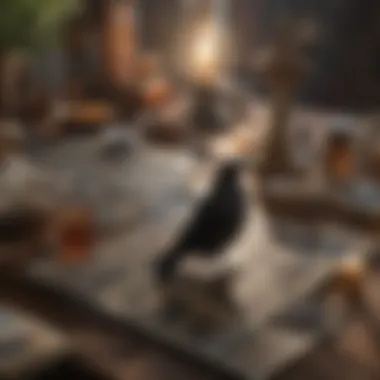
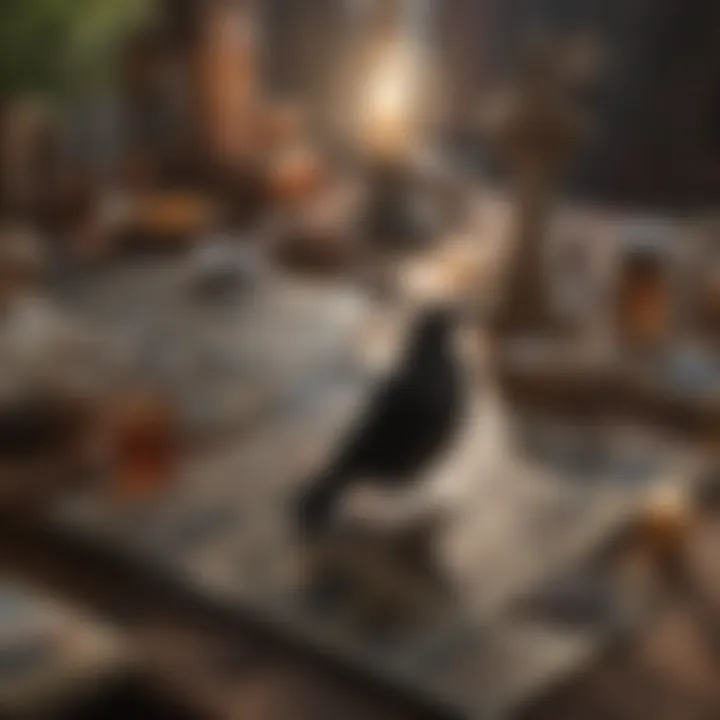
Reversed cards in Crow Tarot can evoke various interpretations based on the context of the reading. They often indicate blockages, delays, or challenges that are preventing the querent from moving forward. However, reversed cards are not inherently negative; they may also suggest a need for reflection or a more profound subconscious understanding of the matter at hand.
When analyzing reversed cards:
- Consider what aspect of the card's upright meaning is being challenged or obscured.
- Explore the potential for internal reflection or reconsideration the card suggests.
- Assess how the reversal shifts the focus of the reading.
The incorporation of reversed cards can deepen interpretations, encouraging readers to delve into the complexities of the querent's situation.
"Every card in the tarot tells a story. Whether upright or reversed, their narratives intertwine to bring clarity and insight."
Integration of Intuition in Readings
Intuition plays a critical role in tarot readings, particularly with the Crow Tarot. This deck holds intricate symbolism and connections with the natural world. Therefore, understanding its use requires more than rote memorization of card meanings. The readings are more resonant when intuition is intricately woven into the process. It allows the reader to engage with their inner self as well as the energies present in the cards.
The integration of intuition into readings provides numerous benefits. Firstly, it encourages personal growth. When practitioners trust their instincts, they enhance their self-awareness and confidence. Moreover, intuition can unlock deeper layers of meaning within the cards. Often, the conventional interpretations are only scratching the surface. Intuitive insights empower the reader to derive unique conclusions based on their situation.
It is also essential to consider some key factors when cultivating intuition. Practice is vital; the more one engages with readings, the more intuition strengthens. Furthermore, a tranquil mindset aids clarity. Avoiding distractions during readings can facilitate deeper connection with both the cards and oneself.
"The answers we seek often lie within us; intuition is the bridge to this knowledge."
Additionally, intuition can enhance the overall experience of a reading. This enables a more fluid and dynamic interaction between the reader and their subject. They can adjust their approach based on the vibes they receive from the cards and the person involved in the reading.
Developing Intuitive Skills
To develop intuitive skills, one must first be willing to explore. It begins with an openness to experience and a refusal to limit oneself. Keeping a tarot journal can significantly aid this process. Write down thoughts and interpretations after each reading. Reflecting on these notes reveals patterns and sparks new insights.
Meditation is another effective technique. A clear mind fosters greater access to intuitive insights. Short daily sessions focused on breath can facilitate this clarity. Over time, practitioners may begin to recognize the subtle nudges of intuition more easily during readings.
Furthermore, actively engaging with nature can enhance intuitive abilities. As crows are associated with the natural rhythm of life, spending time outdoors may provide inspiration and connection. Observing natural phenomena or crows in their environment can spark intuitive insights and deepen the understanding of Crow Tarot's messages.
Trusting Your Inner Voice
Trusting your inner voice is crucial in utilizing intuition effectively. Even the most skilled tarot readers can doubt their interpretations. This skepticism may stem from a fear of making mistakes or not aligning with traditional meanings. Yet, acknowledging and trusting one's insights is equally important as knowing the textbook definitions.
Learning to discern between fear and genuine intuition takes time. It is essential to listen to impulses without immediate judgment. Pay attention to how your body responds—physical sensations often signal intuitive guidance.
When conducting a reading, allow space for your voice to emerge. Silence background chatter and proceed with confidence. At times, unexpected thoughts may surface. These nuggets of insight might lead to profound revelations.
In the end, trusting one's inner voice not only enhances the reading but also makes it a more authentic experience. Thus, the practitioner can facilitate deeper connections with their clients. The interplay of intuition and knowledge creates a dynamic, enriching reading atmosphere.
Practical Applications of Crow Tarot
The relevance of practical applications of Crow Tarot lies in its capacity to assist individuals on their personal journey. Tarot is not merely a tool for fortune telling; it serves as a mirror, reflecting the user's inner world. By utilizing Crow Tarot, one can explore deeper levels of consciousness. Engaging with the cards allows for revelations concerning personal strengths, weaknesses, and opportunities for growth.
Using Crow Tarot for Personal Growth
Personal growth encompasses a broad range of experiences. Engaging with Crow Tarot can provide insights that promote self-awareness. Each card in the deck has distinct meanings, which can trigger revelations. For example, a user might draw the Death card, often misunderstood as solely about endings. Instead, it can represent transformation.
Using the cards in a weekly spread, for instance, offers a structured approach to reflection. Here are some elements to consider in using Crow Tarot for personal development:
- Daily reflections: Draw one card each morning to set an intention.
- Journaling: After readings, write down feelings and thoughts inspired by the cards.
- Meditation: Use specific cards as focal points during meditation to deepen understanding.
Through consistent practice, the insights gleaned can spark profound changes in life choices and perspectives.
Employing Crow Tarot for Decision Making
The uncertain nature of decision making often leads to stress and confusion. Crow Tarot can illuminate choices when faced with challenges. The cards can provide clarity and guidance, allowing individuals to visualize the consequences of various paths.
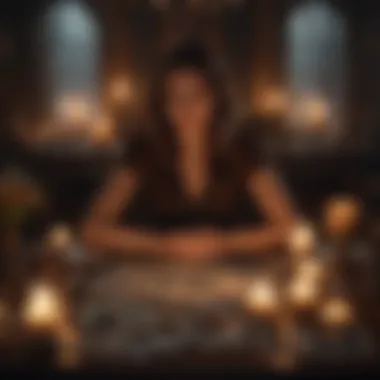
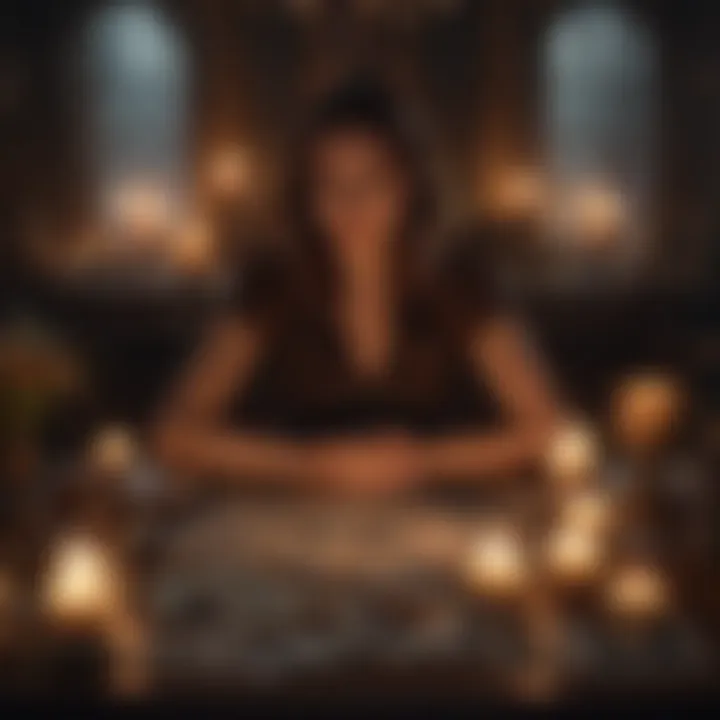
When seeking direction through Crow Tarot, consider these steps:
- Formulate a clear question: Clarifying the issue at hand helps align the reading with desired outcomes.
- Select an appropriate spread: The three-card spread can help reveal past influences, current situations, and potential outcomes.
- Interpret the outcome: Analyze the cards in the context of the question. This interpretation can reveal unseen factors.
In employing the tarot this way, practitioners develop a more insightful means of considering their decisions.
"Tarot acts as a guide, shaping our understanding and approach to the paths we take."
Crow Tarot also encourages trust in one's intuition. Making decisions informed by both emotions and logic can create a balanced approach.
Thus, Crow Tarot offers a reliable resource for personal growth and decision making. As a practical tool, it fosters deeper awareness and enhances decision strategies, aligning individuals with their true selves.
Common Misconceptions About Tarot
The landscape of tarot is riddled with myths and misunderstandings. This section aims to untangle some common misconceptions surrounding tarot, especially within the context of Crow Tarot. Understanding these myths is imperative, as they influence the perception and acceptance of tarot as a legitimate and beneficial tool.
Many view tarot as purely a means of fortune-telling, often relegating it to the realm of superstition. However, tarot serves a far more profound purpose. It is a tool for introspection, self-discovery, and personal growth. This broader perspective is essential to appreciate the full significance of Crow Tarot and its nuanced symbolism.
In addition, myths about tarot can deter newcomers from exploring its potential. Recognizing these misconceptions not only demystifies the practice but also enhances its accessibility. Thus, it is vital for both practitioners and those interested in tarot to engage with these misunderstandings critically.
Debunking Myths Surrounding Tarot
One persistent myth is that tarot can predict specific future events with absolute certainty. In reality, tarot offers insights into potential outcomes based on current circumstances and personal choices. It reflects the present moment rather than serving as an unyielding predictor. Each reading is influenced by the intuition and interpretation of the reader, making it more of a guidance tool rather than a deterministic prophecy.
Another common belief is that tarot cards carry inherent negative energies or are associated with witchcraft. This notion stems from cultural portrayals and misinterpretations. In fact, tarot can be used for positive affirmation and empowerment. It can encourage individuals to confront their fears and uncertainties, guiding them toward making informed decisions.
Moreover, some assume that only those with a mystical background can read tarot effectively. This notion is misleading. While familiarity with the symbolism and structure of the deck enhances reading skills, anyone can learn to interpret tarot cards thoughtfully. Engaging with Crow Tarot enriches one’s understanding and fosters an intuitive connection.
"Tarot is not a divine decree; it is a conversation with your inner self."
Understanding the Psychological Aspects
The psychological underpinnings of tarot are crucial to its effectiveness as a tool. Many practitioners recognize that tarot reading taps into the subconscious mind, allowing the reader to access hidden thoughts and feelings. This aspect turns tarot into a reflective practice where individuals can identify patterns and blockages in their lives.
Cognitive theories suggest that the imagery and symbols in tarot cards resonate with our psyche. They can trigger emotional responses that lead to valuable insights. As such, the interaction with Crow Tarot cards is not merely about interpretation, but about engaging in a dialogue with oneself. This self-dialogue can reveal how past experiences shape current emotional landscapes.
Furthermore, tarot can aid in coping with anxiety and uncertainty. It invites individuals to explore their feelings and potential future paths without the burden of absolute outcomes. This exploration can enhance emotional resilience, encouraging a proactive approach to challenges.
In summary, debunking common myths and understanding the psychological aspects of tarot enrich our appreciation for Crow Tarot. It transforms the practice from one of superstition into a complex, introspective tool. By addressing these misconceptions, we invite a broader audience to engage meaningfully with tarot.
Closure
The conclusion serves as a vital element in understanding the implications of Crow Tarot in today's context. This section synthesizes previous discussions, summarizing the depth of symbolism, interpretations, and real-world applications present in Crow Tarot readings. Highlighting the ways this practice has evolved in contemporary settings allows readers to appreciate its relevance and adaptability.
One key benefit of incorporating Crow Tarot into personal or professional practices is its ability to deepen self-reflection. The intuitive aspects of this tarot system encourage individuals to examine their inner thoughts and feelings, fostering personal growth.
Moreover, Crow Tarot's unique symbolism can aid in decision-making processes. By offering insightful perspectives, it allows practitioners to navigate complex situations with greater clarity.
Considerations also arise when discussing the societal aspects of tarot, particularly regarding misconceptions that persist in various communities. It is essential to demystify these elements to cultivate an informed understanding of tarot's role in modern spiritual practices.
By recognizing the transformative potential of Crow Tarot, practitioners can elevate their readings to new heights, continually adapting the practice to fit personal or collective needs in a rapidly changing world.
"Crow Tarot offers a blend of ancient wisdom and modern practicality, making it an essential tool for today's seekers of truth."
The Evolution of Crow Tarot in Contemporary Practice
In the current landscape of spiritual practices, Crow Tarot reflects significant evolution. Once considered an esoteric art form, it has gained mainstream acceptance. This transformation can be attributed to a growing interest in personal empowerment and spirituality, bridging ancient beliefs with modern psychological insights.
Today, Crow Tarot resonates with various audiences, including astrologers, tarologists, and esotericists. Each group brings its perspectives, enriching the practice.
The following key trends can be observed in this evolution:
- Integration with Other Disciplines: Practitioners often blend Crow Tarot readings with astrology or psychology. This integration enhances the depth of readings, providing a holistic approach to understanding life’s challenges.
- Digital Presence: There is an increasing presence of Crow Tarot in digital spaces. Social media platforms and online communities offer spaces for sharing insights and experiences. This accessibility has expanded the audience and practice.
- Workshops and Education: Many professionals offer workshops that focus on Crow Tarot, teaching others how to harness its potential for personal transformation. Such educational efforts create a bridge for newcomers, fostering a greater appreciation for the practice.
In essence, the journey of Crow Tarot from obscurity to contemporary relevance highlights its enduring power and adaptability. As practitioners continue to explore its depths and incorporate modern frameworks, we can anticipate further evolution in both individual and collective practices.







